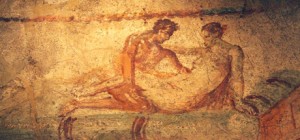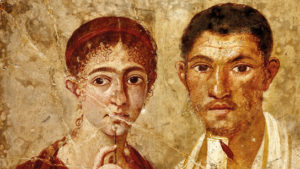In 66 A.D. the first Jewish Revolt against Rome broke out. The war ended in the siege and fall of Jerusalem in 70 A.D. The Romans pretty much leveled the city and destroyed the Second Temple. All that was left of First Century Jerusalem were three towers built by Herod the Great and the retaining or Western Wall (also Herodian) which still stands to this day. In 130 A.D. the Roman Emperor Hadrian (one of the more competent emperors) visited Judea and decided to rebuild Jerusalem only this time as a Roman city with straight streets, a market (or forum) and where the Temple once stood would be a statue of Jupiter Capitolinus. The Jews naturally reacted with outrage and after years of delivering faulty weapons to the Romans which they knew would be rejected and returned, under the leadership of a charismatic leader called Simon Bar-Kochba (a man with messianic inclinations) they launched another revolt (132 – 135 A.D.). This one was extremely brutal and deadly. After initial Judean successes (they destroyed one and possibly two Roman legions), the Romans were forced to bring legions into Judea from all over the Empire and waged a war of extermination. Slowly under their best commander (brought all the way over from Britain) Julius Severus the Romans started to gain the upper hand.
The rebels did not dare try to risk open confrontation against the Romans, but occupied the advantageous positions in the country and strengthened them with mines and walls, so that they would have places of refuge when hard pressed and could communicate with one another unobserved underground; and they pierced these subterranean passages from above at intervals to let in air and light.
The war was a demographic disaster for the Jews, a Roman attempt at genocide which nearly succeeded. Yet Judaism survived because it became decentralized. The center of Judaism shifted from Jerusalem to the north in Galilee and instead of the Temple the synagogues took on importance.
“If it were not pleonastic, one would call the war a disaster. The Romans experienced great difficulties when they tried to subdue Judaea, and they made some progress only after the emperor had personally come to Judaea. The Roman soldiers were used to fight full scale battles, but Simon evaded this kind of engagement. Hadrian’s generals were forced to form smaller units to intercept small groups of rebels. In this war, the highest ranking officers had to stand by doing nothing, while the under-officers had large responsibilities. Famine, disease and fire proved better weapons than swords and lances.“
Severus did not venture to attack his opponents in the open at any one point, in view of their numbers and their fanaticism, but -by intercepting small groups, thanks to the number of his soldiers and under-officers, and by depriving them of food and shutting them up- he was able, rather slowly, to be sure, but with comparative little danger, to crush, exhaust and exterminate them. Very few Jews in fact survived. Fifty of their most important outposts and 985 better known villages were razed to the ground. 580,000 were killed in the various engagements or battles. As for the numbers who perished from starvation, disease or fire, that was impossible to establish.
The Romans too lost heavily, so heavy in fact that they never issued coins celebrating their triumph and built no arches as they had for the previous war (The Arch of Titus in Rome). It was a war that frankly the Romans preferred to forget. Hadrian completed the building of Aelia Capitolina (Aelius being his family name) and to harm the growing Christian faith he built a temple to Venus on the sight of the crucifixion and resurrection of Jesus (where the Church of the Holy Sepulchre now is). Hadrian did not live long enough to celebrate his triumph, he died three years after the Bar-Kochba revolt was crushed. The irony of Aelia Capitolina was that by building it on the ruins of Jerusalem (destroyed in 70 A.D.), the Romans wound up resurrecting Jerusalem. After the end of the Bar-Kochba Rebellion of 132 – 135 A.D., Hadrian in an attempt to deny the Jewish connection to Judea, renamed the province Syria-Palestina after the ancient Philistines.
Anyone visiting the Old City of Jerusalem today will in fact be seeing the remains of Aelia Capitolina.
by Nir Hasson
If you look at a map of the Old City of Jerusalem, you’ll notice something odd. While the vast majority of the Old City’s streets form a crowded casbah of winding alleyways, there are a few straight-as-a-ruler streets that bisect the city from north to south and east to west.
The best known of these straight roads are Beit Chabad and Hagai streets, exiting through the Damascus Gate; David Street, exiting the Jaffa Gate; and the Via Dolorosa.
Like the rest of the Old City’s streets, these straight roads are narrow but, unlike the others, they preserve a historical skeleton of sorts that forms the basis of the Old City we know today. This skeleton was created, most archaeologists agree, not during Jewish, Christian or Muslim rule, but during the Roman period, when the city of Aelia Capitolina was built on the ruins of Jerusalem following the destruction of the Second Temple in 70 AD.
Ironically, it is actually the streets of this imperial and pagan city – which supposedly left behind no cultural or spiritual heritage for modern Jerusalem – that have bequeathed to the city the skeleton structure that has survived to this day.
In the history of Jewish Jerusalem, Aelia Capitolina is the very embodiment of defeat and destruction – a reminder of the humiliation of the Second Temple’s destruction, which erected a pagan temple in its place. This image has distanced Aelia Capitolina from the fathers of Israeli archaeology, who were naturally drawn to the ornate, Jewish city that preceded it. “No one concealed Aelia Capitolina, but we wanted to talk about the Second Temple,” says Dr. Ofer Sion, of the Antiquities Authority. “Aelia Capitolina was an accursed city, a city from which we were banished. It was more idealistic to excavate the Second Temple.”
Almost all of the archaeologists who study Aelia Capitolina call it “an elusive city.” As opposed to the Jerusalem of Second Temple times that preceded it, Aelia Capitolina has not been entirely unearthed during the many excavations that have been performed in the city since 1967. The residents of Aelia Capitolina did not leave written texts like the works of Flavius Josephus during the Second Temple era or of Christian travelers in the following period.
It is known that the Roman city was established by Emperor Hadrian between 130 and 140 AD. After the Bar Kochba revolt of 135, Jews were forbidden to enter the city. Its most important inhabitants were the soldiers of the 10th Legion, who would remain encamped in Jerusalem for 200 years.
Salvage operations
Following the latest wave of excavations, which began in the mid-1990s, more and more archaeologists have become convinced that Aelia Capitolina was a much larger and more important city than was once thought, and its influence on the later development of modern Jerusalem was dramatic.
Aelia Capitolina has sprung to life in a significant way through no less than four extensive excavations that have taken place in the Old City area, and in a number of other digs in other parts of Jerusalem. Most of these digs have been rescue excavations by the Antiquities Authority, salvage digs carried out before new construction and development goes ahead. In a few more years, Aelia Capitolina could again be covered over by new buildings.
In the rear section of the Western Wall plaza, in the spot where the Western Wall Heritage Foundation intends to erect a large building that it calls “the Core House,” Antiquities Authority researcher Shlomit Wexler-Bedolah discovered an ornate and broad Roman street, complete with shops on each side. This is the eastern cardo, along whose path Hagai Street would later be paved.
Three hundred meters to the south, another Antiquities Authority researcher, Dr. Doron Ben-Ami, discovered the place where the Roman street apparently ended. The corner of the street is adjacent to the Givati parking lot at the top of the Silwan valley – the spot where the Elad organization intends to build a large visitors center. In a large rescue excavation at this location in recent years, Ben-Ami exposed a large, fancy Roman villa unlike any other structure from its time in the entire country. He estimates that the villa he uncovered was the home of the regional governor or some other central authority.
In another excavation, in the tunnel under the Western Wall, Wexler-Bedolah and archaeologist Alexander Onn re-estimated the dating of a large bridge leading to the Temple Mount. As with other ancient monuments this too turned out to be of Roman origin and not from the Second Temple period. Another example is the Roman bathhouse and swimming pool discovered by Sion a year and a half ago. “It’s a tremendous spa, a country club,” Sion says, comparing the bathhouse to similar facilities found in other parts of the Roman Empire.
This increasing number of Roman-era discoveries strengthens the notion that the Temple Mount, even after its destruction, did not lie totally barren, but was used for pagan worship rites.
[…..]
The latest excavations give archaeologists much greater insight into Aelia Capitolina than was possible even a decade earlier. Experts agree the city was planned extraordinarily well, based as it was on designs of other cities in the empire and according to orders that came directly from the emperor. It included broad streets, numerous and magnificent entrance gates, temples and infrastructure, and it even housed a new elite of army officers and free soldiers who turned Aelia Capitolina into a thriving city.
“When I began to study the history of the Roman city, it was a barren field,” says Prof. Yoram Zafrir, one of Israel’s most veteran archaeologists. “Today, it is clear that the basic structure of Jerusalem is that of Aelia Capitolina.” Zafrir describes the process by which, after the Roman period, beasts of burden replaced wagons, the central government became weak and streets became “privatized.” This process led to the city that we know today.
“Similarly to the British Mandate, which lasted just 31 years but had a significant impact on modern Jerusalem, from the perspective of architecture, the Roman period established a whole new, imperial language that still holds sway today,” archaeologist Dr. Guy Stiebel concludes. Stiebel even notes the irony of history: “Aelia Capitolina effectively saved Jerusalem. It raised her once again onto the stage of history. She returned like a phoenix from the ashes.”
Read the rest – Archaeologist bringing Jerusalem’s ancient Roman city to life







